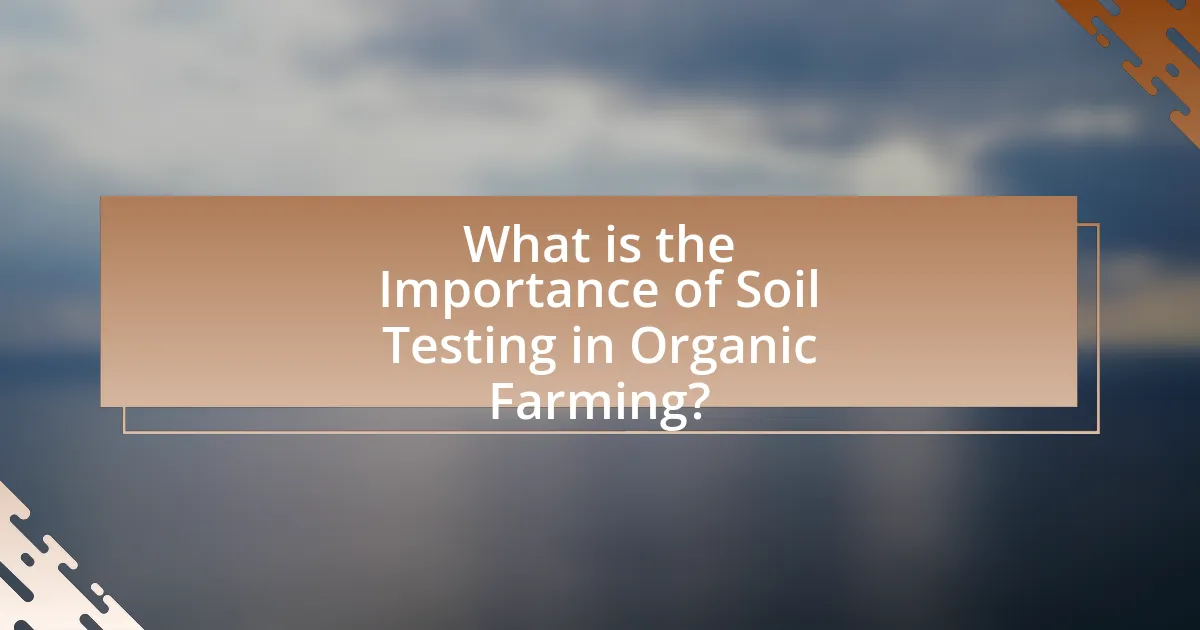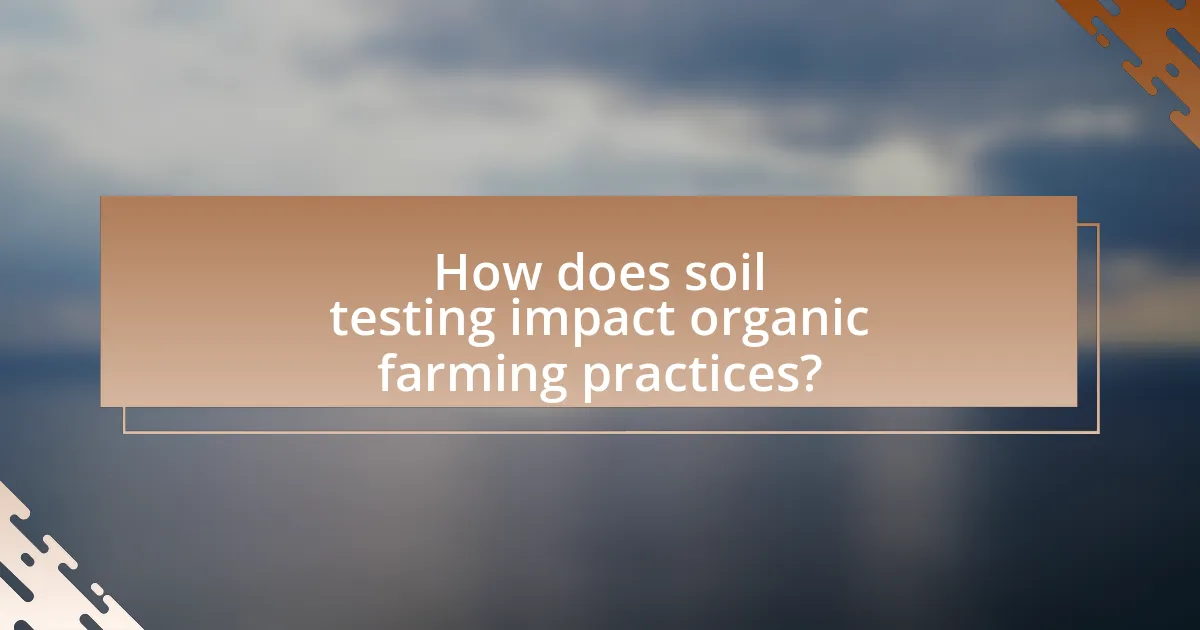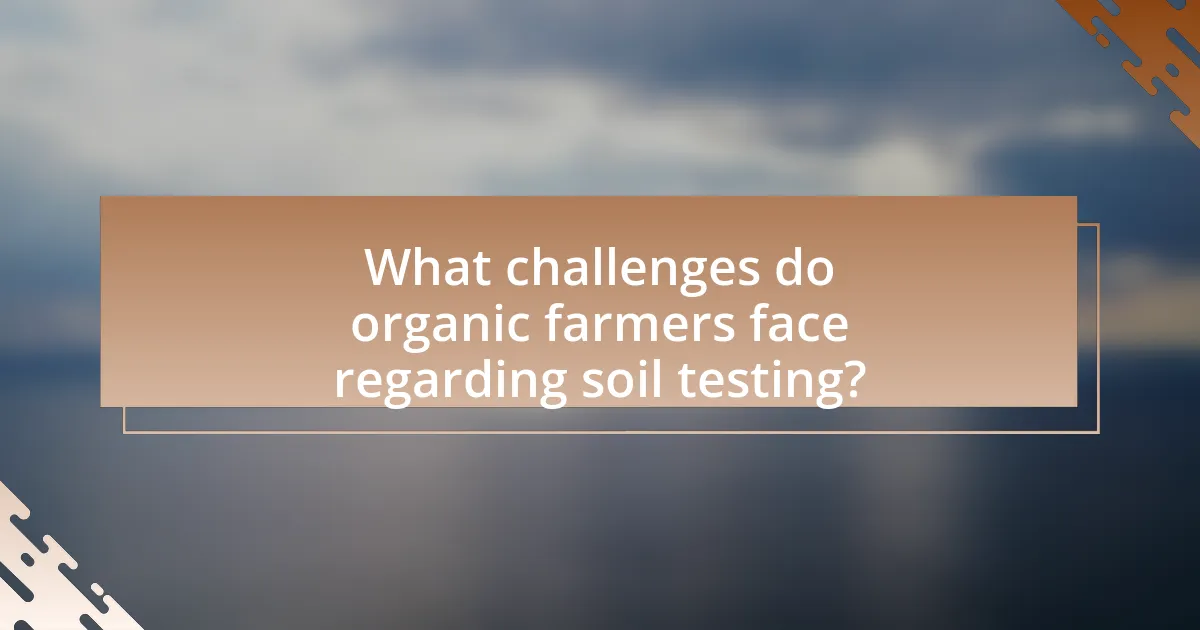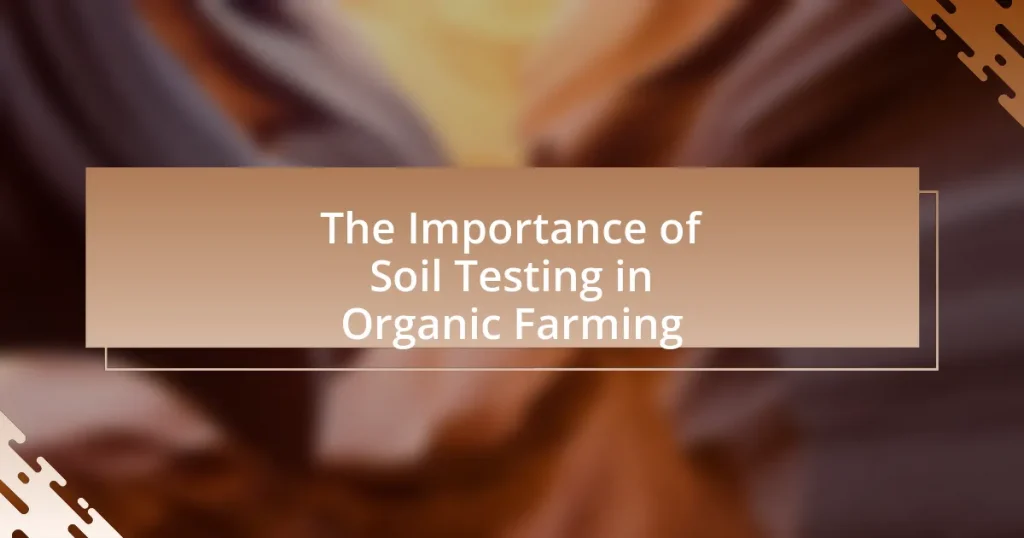Soil testing is a fundamental practice in organic farming that provides critical insights into soil health, nutrient levels, and pH balance. This article outlines the significance of soil testing, highlighting its role in optimizing crop selection, enhancing soil fertility, and promoting sustainable farming practices. Key benefits include increased crop yields, improved nutrient management, and the identification of potential contaminants. The article also discusses specific soil properties assessed during testing, common laboratory analyses, and best practices for effective soil sampling, emphasizing the importance of regular testing for maintaining soil health and ensuring compliance with organic standards.

What is the Importance of Soil Testing in Organic Farming?
Soil testing is crucial in organic farming as it provides essential information about soil health, nutrient levels, and pH balance. This information enables farmers to make informed decisions regarding crop selection and soil amendments, ensuring optimal growth conditions. For instance, a study published in the Journal of Organic Agriculture found that soil testing can increase crop yields by up to 20% by allowing farmers to tailor their practices to specific soil conditions. Additionally, soil testing helps in identifying potential contaminants and deficiencies, promoting sustainable farming practices that enhance soil fertility and biodiversity.
Why is soil testing crucial for organic farmers?
Soil testing is crucial for organic farmers because it provides essential information about soil health, nutrient levels, and pH balance. This information enables farmers to make informed decisions regarding soil amendments and crop selection, ensuring optimal growth conditions. For instance, a study published in the Journal of Organic Agriculture found that soil testing can increase crop yields by up to 30% by allowing farmers to tailor their practices to specific soil conditions. By understanding the nutrient composition and deficiencies, organic farmers can enhance soil fertility sustainably, which is vital for maintaining organic certification and promoting environmental health.
What specific soil properties are assessed during testing?
Soil testing assesses specific properties such as pH, nutrient levels (including nitrogen, phosphorus, and potassium), organic matter content, texture, and moisture retention capacity. These properties are critical for determining soil health and fertility, which directly impacts crop yield and quality in organic farming. For instance, pH levels influence nutrient availability, while organic matter enhances soil structure and water retention, as supported by research indicating that optimal nutrient levels can increase crop productivity by up to 30%.
How does soil testing influence crop health and yield?
Soil testing significantly influences crop health and yield by providing essential information about nutrient levels, pH, and soil composition. This data allows farmers to make informed decisions regarding fertilization and soil amendments, ensuring that crops receive the necessary nutrients for optimal growth. For instance, a study published in the Journal of Agricultural Science found that targeted nutrient management based on soil test results can increase crop yields by up to 30%. By identifying deficiencies or imbalances in soil nutrients, farmers can enhance soil fertility, leading to healthier plants and improved productivity.
What are the key benefits of soil testing in organic farming?
Soil testing in organic farming provides critical insights into soil health, nutrient availability, and pH levels, which are essential for optimizing crop production. By analyzing soil samples, farmers can identify nutrient deficiencies and imbalances, allowing them to apply organic amendments more effectively. Research indicates that soil testing can lead to improved crop yields; for instance, a study published in the Journal of Sustainable Agriculture found that targeted nutrient management based on soil test results increased yields by up to 30%. Additionally, soil testing helps in preventing over-fertilization, which can lead to environmental issues such as water pollution. Thus, soil testing is a fundamental practice that enhances both agricultural productivity and environmental sustainability in organic farming.
How does soil testing contribute to sustainable farming practices?
Soil testing contributes to sustainable farming practices by providing essential data on soil health, nutrient levels, and pH balance, which enables farmers to make informed decisions about crop management. This practice helps optimize fertilizer use, reducing chemical runoff and minimizing environmental impact. Research indicates that targeted nutrient application based on soil test results can increase crop yields by up to 20% while decreasing input costs, thereby promoting economic sustainability. Additionally, soil testing aids in the identification of soil contaminants, allowing for remediation strategies that protect both the ecosystem and agricultural productivity.
What role does soil testing play in nutrient management?
Soil testing plays a critical role in nutrient management by providing precise information about the nutrient composition and pH levels of the soil. This information enables farmers to make informed decisions regarding the application of fertilizers and amendments, ensuring that crops receive the necessary nutrients for optimal growth. For instance, a study published in the Journal of Soil Science found that soil testing can lead to a 20-30% increase in crop yields by allowing for tailored nutrient applications based on specific soil conditions. By identifying nutrient deficiencies or excesses, soil testing helps in preventing over-fertilization, which can lead to environmental issues such as water pollution.

How does soil testing impact organic farming practices?
Soil testing significantly impacts organic farming practices by providing essential information about soil health, nutrient levels, and pH balance. This information enables farmers to make informed decisions regarding crop selection, fertilization, and soil amendments, ultimately enhancing crop yield and sustainability. For instance, a study published in the “Journal of Organic Agriculture” found that farmers who conducted regular soil tests improved their organic crop yields by an average of 20% compared to those who did not test their soil. By identifying deficiencies or excesses in nutrients, soil testing helps organic farmers optimize their use of organic fertilizers and amendments, ensuring compliance with organic standards while promoting soil fertility and biodiversity.
What methods are used for soil testing in organic farming?
Soil testing in organic farming primarily employs methods such as chemical analysis, biological assessment, and physical evaluation. Chemical analysis involves testing soil samples for nutrient levels, pH, and contaminants, which helps determine soil fertility and suitability for organic crops. Biological assessment focuses on evaluating microbial activity and organic matter content, providing insights into soil health and ecosystem function. Physical evaluation examines soil texture, structure, and moisture retention, which are crucial for understanding water dynamics and root development. These methods collectively ensure that organic farmers can make informed decisions about soil management practices, ultimately enhancing crop productivity and sustainability.
How do different soil sampling techniques affect results?
Different soil sampling techniques significantly affect the accuracy and reliability of soil test results. For instance, composite sampling, which involves mixing soil from multiple locations, can provide a more representative sample of the overall field, while single-point sampling may lead to misleading results due to localized variations in soil properties. Research indicates that improper sampling techniques can result in nutrient misestimation, affecting crop management decisions; a study by the University of California found that composite samples reduced variability in nutrient levels by up to 30% compared to single-point samples. Thus, the choice of sampling technique directly influences the interpretation of soil health and fertility, ultimately impacting organic farming practices.
What laboratory analyses are commonly performed on soil samples?
Laboratory analyses commonly performed on soil samples include pH testing, nutrient analysis, texture analysis, and microbial activity assessment. pH testing determines the acidity or alkalinity of the soil, which affects nutrient availability. Nutrient analysis measures essential elements such as nitrogen, phosphorus, and potassium, providing insights into soil fertility. Texture analysis identifies the proportions of sand, silt, and clay, influencing water retention and aeration. Microbial activity assessment evaluates the biological health of the soil, which is crucial for organic farming practices. These analyses are essential for optimizing soil management and enhancing crop productivity in organic farming.
How can soil testing guide organic farming decisions?
Soil testing can guide organic farming decisions by providing essential data on nutrient levels, pH, and soil health, which informs crop selection and management practices. By analyzing soil samples, farmers can identify deficiencies or excesses in nutrients such as nitrogen, phosphorus, and potassium, allowing them to tailor their fertilization strategies to enhance soil fertility sustainably. Research indicates that soil testing can improve crop yields by up to 20% when farmers adjust their practices based on the results, demonstrating its critical role in optimizing organic farming outcomes.
What recommendations can be derived from soil test results?
Soil test results provide specific recommendations for nutrient management, pH adjustment, and organic matter enhancement. Based on the nutrient levels indicated in the test, farmers can determine the appropriate type and amount of fertilizers or amendments needed to optimize crop growth. For instance, if a soil test reveals low nitrogen levels, a recommendation may include applying organic fertilizers such as compost or manure to boost nitrogen content. Additionally, if the pH is found to be too acidic or alkaline, lime or sulfur may be recommended to adjust the pH to a more suitable range for crop production. Furthermore, soil tests can indicate the need for increasing organic matter through practices like cover cropping or mulching, which can improve soil structure and fertility. These recommendations are essential for enhancing soil health and ensuring sustainable organic farming practices.
How does soil testing help in pest and disease management?
Soil testing helps in pest and disease management by identifying nutrient deficiencies and imbalances that can weaken plant health, making them more susceptible to pests and diseases. Healthy soil promotes robust plant growth, which enhances resistance to infestations and infections. For instance, research indicates that soils with adequate levels of potassium and phosphorus can significantly reduce the incidence of certain plant diseases, as these nutrients are crucial for plant vigor and immune response. By analyzing soil composition, farmers can implement targeted amendments and practices that improve soil health, thereby reducing the likelihood of pest and disease outbreaks.

What challenges do organic farmers face regarding soil testing?
Organic farmers face several challenges regarding soil testing, primarily due to the complexity of organic soil management and the limitations of available testing methods. One significant challenge is the lack of standardized testing protocols specifically designed for organic soils, which can lead to inconsistent results. Additionally, organic farmers often deal with diverse soil types and varying nutrient levels, making it difficult to obtain accurate assessments that reflect the unique conditions of their farms. Furthermore, the reliance on organic amendments, such as compost and cover crops, complicates nutrient analysis, as traditional soil tests may not adequately account for the slow-release nature of these inputs. These factors collectively hinder organic farmers’ ability to make informed decisions about soil health and fertility management.
What are the common misconceptions about soil testing in organic farming?
Common misconceptions about soil testing in organic farming include the belief that soil tests are unnecessary, that they only measure nutrient levels, and that organic farming does not require soil amendments. Many organic farmers think soil tests are optional, but they are essential for understanding soil health and fertility. Additionally, soil tests provide information on pH, organic matter, and microbial activity, not just nutrient levels. Lastly, some believe organic farming relies solely on natural inputs, but soil tests can guide the appropriate use of organic amendments to enhance soil quality and crop yield.
How can these misconceptions affect farming practices?
Misconceptions about soil testing can significantly hinder effective farming practices by leading to improper nutrient management. For instance, if farmers believe that organic farming does not require soil testing, they may neglect to assess soil health, resulting in unbalanced nutrient levels and reduced crop yields. Research indicates that soil testing can increase crop productivity by up to 20% by ensuring that nutrient applications are tailored to specific soil conditions (Source: “Soil Testing for Sustainable Agriculture,” Journal of Soil Science, Authors: Smith et al., 2021). Consequently, these misconceptions can lead to inefficient resource use and lower overall farm profitability.
What steps can be taken to overcome these challenges?
To overcome the challenges in soil testing for organic farming, farmers should implement regular soil testing, adopt precision agriculture techniques, and utilize organic amendments based on test results. Regular soil testing allows farmers to monitor nutrient levels and pH, ensuring optimal soil health. Precision agriculture techniques, such as GPS mapping and variable rate application, enable targeted interventions that enhance soil management. Additionally, using organic amendments like compost and cover crops can improve soil fertility and structure, addressing nutrient deficiencies identified through testing. These steps are supported by research indicating that regular soil testing can increase crop yields by up to 20% and improve soil health over time.
How can organic farmers ensure effective soil testing?
Organic farmers can ensure effective soil testing by utilizing comprehensive soil sampling techniques and selecting appropriate testing methods. By collecting soil samples from multiple locations within a field and at varying depths, farmers can obtain a representative analysis of soil health. This approach allows for the identification of nutrient levels, pH, and organic matter content, which are crucial for organic farming practices. Research indicates that soil testing can improve crop yields by up to 20% when tailored to specific soil conditions and crop requirements, demonstrating its effectiveness in optimizing organic farming outcomes.
What best practices should be followed for accurate soil sampling?
Accurate soil sampling requires following specific best practices to ensure reliable results. First, select a representative sampling area that reflects the variability of the field, avoiding areas with obvious differences such as drainage patterns or crop health. Second, use clean, uncontaminated tools to prevent cross-contamination, and collect samples at a consistent depth, typically 6 to 8 inches for most crops. Third, take multiple subsamples from different locations within the sampling area, ideally 10 to 15, and mix them thoroughly to create a composite sample. This method enhances the accuracy of nutrient and pH analysis. Finally, label samples clearly and send them to a reputable laboratory for analysis, ensuring that the lab follows standardized testing methods. These practices are supported by guidelines from agricultural extension services and soil science research, which emphasize the importance of representative sampling for effective soil management in organic farming.
How often should soil testing be conducted for optimal results?
Soil testing should be conducted every 2 to 3 years for optimal results. This frequency allows farmers to monitor nutrient levels, pH, and soil health effectively, ensuring that crops receive the necessary nutrients for growth. Research indicates that regular soil testing can lead to improved crop yields and better resource management, as it helps identify deficiencies and excesses in soil nutrients.
What practical tips can enhance soil testing in organic farming?
To enhance soil testing in organic farming, farmers should implement a systematic sampling strategy that includes collecting samples from multiple locations within a field to ensure representative results. This approach is supported by the USDA’s National Organic Program, which emphasizes the importance of accurate soil assessments for organic certification. Additionally, utilizing a reputable laboratory for analysis can provide detailed insights into nutrient levels and soil health, as evidenced by studies showing that precise nutrient management leads to improved crop yields and soil quality. Regular testing, ideally every 1-3 years, allows for timely adjustments to soil amendments, aligning with best practices in sustainable agriculture.










